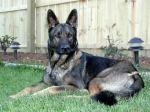I was watching a Wrestling match on the tube the other night
and one of the competitors was the guy we all know as…
“The Rock” aka. Dwayne Johnson.
I enjoy watching him wrestle, and yes I am well aware
that it is all scripted and fake as hell.
But..I still find it entertaining none the less.
Now I know you’re thinking what has this got to do with dog training.
Bear with me and it will all become clear in a minute or so..
What I like about the Rock is how he is able to use facial expressions
and body language to let his fans know what is coming next.
For example..he has a move called “The Peoples Elbow” a devastating blow
delivered by smashing his elbow into his opponent’s chest and in most cases is
the move that finishes them off..
You know what is coming not because he says anything but by the way he
stops, and looks out at the crowd,slides his elbow pad off,
then stares down at his opponent, and after a couple of springs off the
ropes delivers his signature blow.
He is what you could call a Master in using facial expressions and body
language to communicate his intentions..
Over the years I have learned and perfected how to use my body language
and tone of voice to have a powerful effect on how my dogs behave.
Let me break it down for ya…
You see your dog has three main drives,a defence drive,pack drive,and
a prey drive.
1- Guard Drive
This is a dogs instinctual reaction to a stressful situation, and of the three
drives this is the most diverse because it is determined by the dogs temperament
they will either fight or run away depending on their temperament.
If you have a confident dog that is not easily spooked by noise, other dogs or people,
they will most likely fight if cornered or pushed.
If you have a dog that is easily frightened by noise, other dogs or people
then this dog will likely run away in the face of adversity.Sometimes they will
just freeze and not move a muscle.
2- Pack Drive
Pack drive is the drive that your dogs are in when they work with you or interact with
a group of dogs. This is the drive you want your dog in when you work obedience exercises
or go for walks.
3- Prey Drive
This is the drive that causes your dog to want to chase sticks or squirrels.
This is the drive that you want your dog in when you call them to come.
Now how does your tone of voice and body language kick in these drives?
I’m glad you asked.
Have you ever layed down on the grass and notice that your dog almost immediately
runs to you and jumps and rolls on you having a great time. That’s because when you
lower your body to the ground it kicks in your dogs prey drive..they instinctually
are driven to play, because you pose no threat to them when you are on the ground.
You want your dog to be in prey drive when you call them to come..so make sure you
squat down and use a high-pitched happy tone of voice when you call them to come.
If you stand tall and lean in toward your dog and use harsh tones then you will
shift your dog into guard drive and they will most likely not come to you or
be very hesitant and almost crawl to you on their bellys, because they are unsure
of what is going to happen to them.
When you stand straight, and use calming even tones you will kick in your dogs pack
drive and this is the drive you want them in when you go for walks or teaching
obedience.
So to sum this all up..
It’s important to understand how your tone of voice and body language switches your
dog’s drive..because when you are working obedience commands you will want to change
your dogs drive to have success with different commands.
If you want to work with your dog or go for walks, then stand straight, use normal
even tones in your voice to kick in their pack drive, and your dog will follow you
and be very willing to work with you.
If you want your dog to come, squat down, or lean back, use high-pitched happy tones of
voice, this will kick your dog into prey drive and in most cases your dog will come
running to you.
If you want to kick in your dogs guard drive..stand tall, lean in toward the dog and
use a stern tone of voice.
This is a good drive to use when your dog is a little too excited and out of hand, not
responding to your commands.
Stand up tall and lean toward your dog and in a harsh low commanding tone of voice say,
“Hey, that’s enough!”
and in most cases the dog will hunker down, and start paying attention to you.
So remember if you want your dog to come then guard drive is not the drive you want..
a dog will find it very hard to come to you if you have kicked in their guard drive.
If you liked this post let me know by liking my Face Book Page
Click Here====> River Valley Dog Training
all the best,
Harley
















 a very effective deterrent in and of itself.
a very effective deterrent in and of itself.